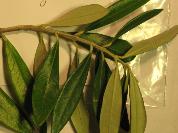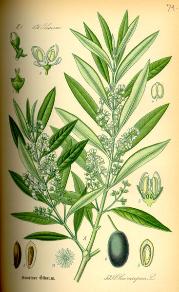We provide identification of Olea cultivars by DNA fingerprinting of plant material. DNA
fingerprinting is a method used routinely for varietal identification in several major field
and horticultural crops, such as grapes, olives, walnuts, plums and melons.
What analyses do we provide?
- Variety Confirmation consists in determining whether a sample's fingerprint
is a close match to the fingerprint of the stated or suspected cultivar. Allowing
for minimal clonal variance, the target fingerprint is either matched or
mismatched.
- Variety Determination consists in determining the likely identity of an unknown
sample. The process identifies the cultivars whose known fingerprint most
closely match the sample's fingerprint.
How to submit samples for analysis?
Contact us to coordinate so we can answer your questions, anticipate your
needs and timing (click here for our contact information.)
- Collect samples from each tree you need to identify. (See info below)
- Label each sample uniquely (click here for labels)
- Fill out submission form(s) listing all samples (click here for a form)
- Ideally, send the samples by overnight delivery.
- Be ready to work with us through this process, which depending on the
number of samples may take anywhere from 3 to 8 weeks.
|
|
How should samples be collected?
Healthy young leaves are usually preferred as samples. Twigs with at least six
to ten leaves should be collected and placed in labeled "zip-lock" bags to
simplify handling.
There should only be the natural moisture of the leaves, without dew or water
drops on them.
Sample descriptors typically reflect the specific tree and area where they were
collected from, in addition to the suspected cultivar, if known.
What does the identification process entail?
DNA is extracted from the samples, and then is subject to amplification. This is
an accelerated, time-compressed multiplication of specific regions of the DNA.
By simultaneously analyzing several DNA regions that differ among cultivars, a
unique pattern (a "fingerprint") is assembled and then used to match against
established cultivar fingerprints in a database.
The sample's fingerprint pattern is matched to the closest entries in the
database. Search for the best match is complemented with morphological and
agronomic traits of the sampled plant.
What database is used?
We have compiled an extensive database that includes the fingerprints of
hundreds of varieties from Italy, Spain, France, Middle East, Northern Africa and
Greece.
Research on variety identification of Olea cultivars has been ongoing for many
years, primarily to properly identify the genetic material in repositories across
multiple countries. Our database builds on publications from this ongoing
research.
Are samples' fingerprints always found in the
database?
Sometimes, sample fingerprints may not be present in the database, possibly
for several reasons:
- The sample submitted may truly be unique to a nursery or an area
where it has developed. It may have never been fingerprinted.
- The plant sampled may be a result of a genetic mutation that is not
widely disseminated.
Note that unique cultivars that have very desirable traits (superb olive oil quality
or yield), or important agronomic traits (cold or disease resistance) may be
candidates for plant registration and intellectual property protection. DNA
fingerprinting of such specimens uniquely identifies them.
|
|
What is coming up in DNA fingerprinting?
We are developing detection by DNA fingerprinting, of olive oil adulteration with
other oils from seeds or nuts.
For further information, please contact us. (Click here for our contact
information.)
|
|
|








